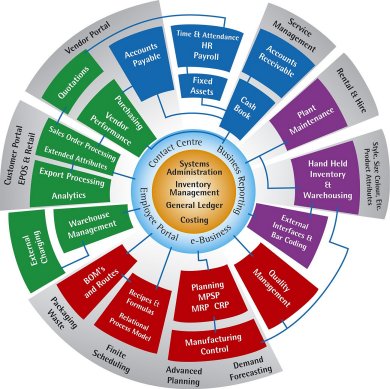
Enterprise
ERP and CRM are two major
applications found in nearly all medium to large-sized organizations.
ERP systems are the large
accounting and operating systems which capture most of the transactions in an
organization, such as inventory control, accounts receivable, accounts payable,
general ledger, human resource management (payroll, benefits), etc. Most large organizations license ERP
systems from the major ERP suppliers such as SAP and Oracle. These systems are
the “back office” or “foundational” systems in most
organizations, and therefore are a vital component of the services provided by
IT departments to internal users.
CRM systems are systems at
the front end of the supply chain.
CRM systems integrate customer contact points such as phone calls,
email, fax, face-to-face, and internet to provide product and service
information, to process orders, to collect payments, to deliver products, and
to service customers before, during and after the sale. Most large organizations license CRM
systems from the major CRM suppliers such as Seibel and Convergys. Many CRM systems are also integrated
back into the ERP systems.
Because these applications are large, expensive,
and challenging to implement, your group should focus on only one—either
ERP or CRM.
Your group might begin the presentation with size
of the ERP market in terms of dollars, the promised benefits of ERP, and the
potential pitfalls. The idea
is to convince the audience that the topic is important to general
managers. Next you will have to
fully explain the concept of ERP:
From Wikipedia: “
Some conceptual
pictures might help, such as:

Source: http://www.itwales.com/cgi/showsite/images/998919Answer_BK.jpg
viewed Dec 19, 2006
A 5 minute video or demo would also be a
great way to explain ERP to the class!
The group might cover the revenue, profits,
stock price, strategies of major
the ERP suppliers.
The meat of the presentation might be one or two case studies of
organizations that have adopted ERP and how ERP affected the
organizations’ business processes. There are many ERP implementations in
Provide the Company Background by including:
- Size of company in terms of sales and profits
- Major products the company sells
- General characteristics of their customers
- Organizational chart--who does the CIO report to?
- How many people work for the IT organization?
- What is the annual IT budget?
The ERP project case should
include:
- Project scope, time and budget estimate
- Actual project delivery date and budget
- Use of outside consultants
- Changes in business processes
- Degree of success and failure of the project
- Lessons learned by the company
The group should end the
presentation on best practices for ensuring successful ERP projects. Are there practices unique to ERP or
are the best practices the same for any large IT-enabled project we learned
about in class?
If you have other creative ideas, please
feel free to discuss them with me.
Customer
Relationship Management
The group may begin by briefly explaining the
CRM concept, presenting statistics on the dollars spent on CRM, industry
leaders, and arguments why retaining and upselling to current customers is more
profitable than attracting new customers.
Some conceptual
pictures might help, such as:

Source:
http://www.dmreview.com/editorial/dmreview/199912/1999rg_004_2.gif viewed on Dec 19, 2006
A 5 minute video or demo would also be a
great way to explain the CRM to the class!
The group might cover the revenue, profits,
stock price, strategies of major
the CRM suppliers.
Ideally, your presentation should include
one or two case studies of organizations that have adopted CRM and how it
affected the organization.
If you do a case study, provide the Company
Background by including:
- Size of company in terms of sales and profits
- Major products the company sells
- General characteristics of their customers
- Organizational chart--who does the CIO report to?
- How many people work for the IT organization?
- What is the annual IT budget?
The CRM project case should
include:
- Project scope, time and budget estimate
- Actual project delivery date and budget
- Use of outside consultants
- Changes in business processes (does the customer notice a
difference?)
- How data collected with CRM is analyzed and used
- Degree of success and failure of the project
- Lessons learned by the company
It would be great if we could actually see
the CRM system--what do the screens look like, who uses the information
captured?
The group should end the
presentation on best practices for ensuring successful CRM projects. Are there practices unique to CRM or are
best practices the same as other large IT-enabled projects?
Other potential ideas for the presentation:
- A brief overview or demonstration of CRM software (10 minutes or
less)
- Lists of companies adopting CRM
- Issues with outsourcing CRM
If you have other creative
ideas, please feel free to discuss them with me.
Some helpful readings:
Goodhue, D., Wixom, B., and
Watson, H., "Realizing
Business Benefits Through CRM: Hitting the Right Target in the Right Way,"
MIS Quarterly Executive, Vol. 1, 2, June 2002, pp. 79-94.
Swift, R., "Executive Response: CRM is
Changing Our Eras, "
MIS Quarterly Executive, Vol. 1, 2, June 2002, pp. 95-96.